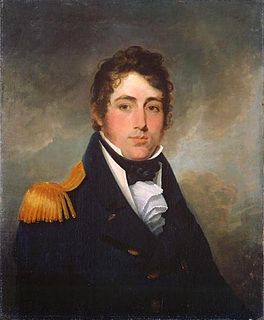
Admiral of the Fleet Sir Provo William Parry Wallis, was a Royal Navy officer. As a junior officer, following the capture of USS Chesapeake by the frigate HMS Shannon during the War of 1812, the wounding of HMS Shannon's captain and the death of her first lieutenant in the action, he served as the temporary captain of HMS Shannon as she returned to Halifax, Nova Scotia, with Chesapeake.

HMS La Hogue was a 74-gun third-rate ship of the line of the Royal Navy, launched on 3 October 1811 at Deptford. She was named after the 1692 Battle of La Hogue. "The La Hogue of 1811 [...] sported a green and chocolate lion, its grinning mouth displaying rows of white teeth and a huge red tongue."

Sir Philip Bowes Vere Broke, 1st Baronet was a distinguished officer in the British Royal Navy. During his lifetime he was often referred to as Broke of the Shannon, a reference to his notable command of HMS Shannon in the War of 1812. His most famous military achievement was defeating and capturing the American frigate, USS Chesapeake.

HMS Shannon was a 38-gun Leda-class frigate of the Royal Navy. She was launched in 1806 and served in the Napoleonic Wars and the War of 1812. She won a noteworthy naval victory on 1 June 1813, during the latter conflict, when she captured the United States Navy frigate USS Chesapeake in a singularly bloody battle.

Canadian Forces Base (CFB) Halifax is Canada's east coast naval base and home port to the Royal Canadian Navy Atlantic fleet, known as Canadian Fleet Atlantic (CANFLTLANT), that forms part of the formation Maritime Forces Atlantic (MARLANT).
Sir John Sherbrooke was a successful and famous Nova Scotian privateer brig during the War of 1812, the largest privateer from Atlantic Canada during the war. In addition to preying on American merchant ships, she also defended Nova Scotian waters during the war. After her conversion to a merchantman she fell prey to an American privateer in 1814. She was burnt to prevent her reuse.
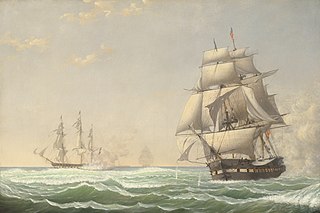
The capture of USS President was one of many naval actions fought at the end of the War of 1812. The frigate USS President tried to break out of New York Harbor but was intercepted by a British squadron of four warships and forced to surrender.
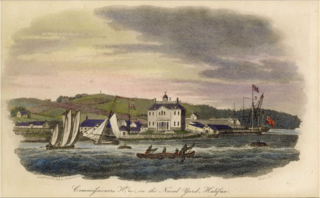
Royal Naval Dockyard, Halifax was a Royal Navy base in Halifax, Nova Scotia. Established in 1759, the Halifax Yard served as the headquarters for the Royal Navy's North American Station for sixty years, starting with the Seven Years' War. The Royal Navy continued to operate the station until it was closed in 1905. The station was sold to Canada in 1907 becoming Her Majesty's Canadian Dockyard, a function it still serves today as part of CFB Halifax.
Liverpool Packet was a privateer schooner from Liverpool, Nova Scotia, that captured 50 American vessels in the War of 1812. American privateers captured Liverpool Packet in 1813, but she failed to take any prizes during the four months before she was recaptured. She was repurchased by her original Nova Scotia owners and returned to raiding American commerce. Liverpool Packet was the most successful privateer vessel ever to sail out of a Canadian port.
HMS Pictou was a 14-gun schooner that the Royal Navy captured in 1813. She served briefly on the Royal Navy's North American station, capturing one or two merchantmen before the American frigate USS Constitution captured her during the War of 1812.
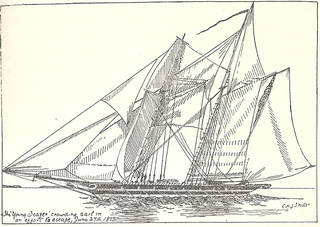
Young Teazer was a United States privateer schooner that captured 12 British vessels, five of which made it to American ports. A member of her crew blew her up at Mahone Bay, Nova Scotia during the War of 1812 after a series of British warships chased her and after HMS Hogue trapped her. The schooner became famous for this deadly explosion, which killed most of her crew, and for the folklore about the ghostly "Teazer Light."
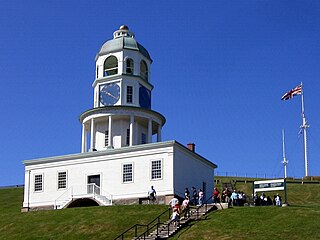
This timeline of the History of the Halifax Regional Municipality documents all events that had happened in Halifax, Nova Scotia, Canada, including historical events in the former city of Dartmouth, the Town of Bedford and Halifax County. Events date back to the early-18th century and continue until the present in chronological order.
HMS Mackerel was a Royal Navy Ballahoo-class schooner of four 12-pounder carronades and a crew of 20. The prime contractor for the vessel was Goodrich & Co., in Bermuda, and she was launched in 1804. Given that she served entirely during the Napoleonic Wars and the War of 1812, she had an unusually peaceful and uneventful career, primarily on the Newfoundland Station, before she was sold in 1815.
HMS Curlew (1812) was a Royal Navy Cruizer class brig-sloop built by (William) Good & Co., at Bridport and launched in 1812. She served with the Navy for only 10 years. During the War of 1812 she sailed from Halifax and captured several American privateers. Her greatest moment was her role in the 1819 British occupation of Ras al-Khaimah. Curlew was sold in 1822 in Bombay. She then had a 13 or so year career as an opium runner for James Matheson, one of the founders of the firm Jardine Matheson.

The Naval Museum of Halifax is a Canadian Forces museum located at CFB Halifax in the former official residence of the Commander-in-Chief of the North America Station (1819–1905). Also known as the "Admiralty House", the residence is a National Historic Site of Canada located in Halifax, Nova Scotia, Canada. The museum collects, preserves and displays the artifacts and history of the Royal Canadian Navy.

The Battle off Halifax took place on 28 May 1782 during the American Revolutionary War. It involved the American privateer Jack and the 14-gun Royal Naval brig HMS Observer off Halifax, Nova Scotia. Captain David Ropes commanded Jack, and Lieutenant John Crymes commanded Observer. The battle was "a long and severe engagement" in which Captain David Ropes was killed.

Impressment by the Royal Navy in Nova Scotia happened primarily during the American Revolution and the Napoleonic Wars. Guard boats patrolled Halifax harbour day and night and they boarded all incoming and outgoing vessels. The Navy always struggled with desertion in Nova Scotia, and it often threatened to use impressment as a punishment for communities that harboured and assisted deserters. The Navy used guard boats as floating press gangs, conscripting every fiftieth man out of ships entering the harbour. It even pressed Americans from cartels and prison hulks. Warships shot at vessels to bring them to, damaging their sails and rigging, and at least one fisherman was pressed while checking his nets.
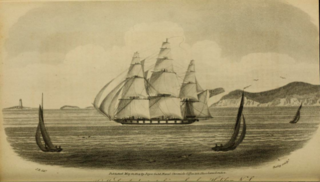
HMS Atalante was an 18-cannon sloop-of-war launched in 1808 in Bermuda. She was wrecked on 10 November 1813 because of fog off Halifax, Nova Scotia.

The Royal Navy Burying Ground is part of the Naval Museum of Halifax and was the Naval Hospital cemetery for the North America and West Indies Station at Halifax, Nova Scotia. It is the oldest military burial ground in Canada. The cemetery has grave markers to those who died while serving at Halifax and were treated at the Naval medical facility or died at sea. Often shipmates and officers had the grave markers erected to mark the deaths of the crew members who died while in the port of Halifax.

Dr. David D. Rowlands, M.D., F.R.S., F.A.S. (1778–1846) was a Welsh naval surgeon, who became the Inspector of H.M. Hospital and Fleets for the Royal Navy. He had the distinction of being the Surgeon for the Royal Navy at Halifax when he treated the wounded of HMS Shannon, including Captain Philip Broke, after the renown Capture of USS Chesapeake during the War of 1812. He was a Fellow of the Royal Society and a Fellow of the Antiquarian Society. He also supported the Governesses' Benevolent Institution in London (1844).














